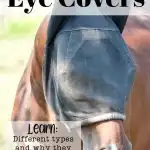If you’ve ever seen a horse frolicking in a field wearing a blindfold, you might be wondering what the heck the owner was thinking. Or, maybe you’ve visited a racetrack and seen the horses wearing strange eye coverings while they race.
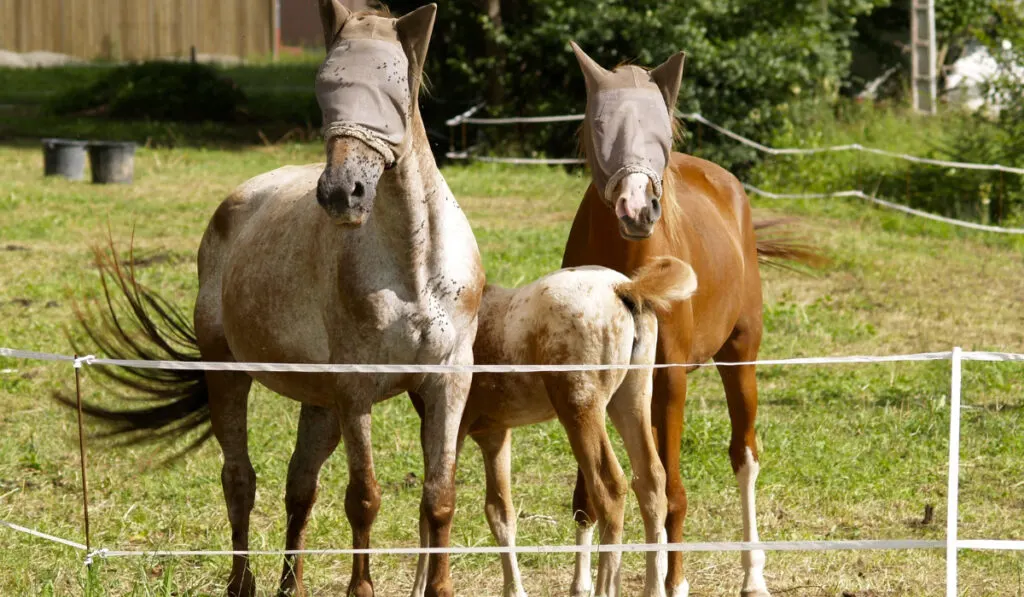
Why are horses eyes covered? Horses eyes are usually covered with transparent mesh to prevent flies from biting at their eyes. This fly-mask allows the horse to see and hear just fine but prevents flies from gathering on their face and eyes.
If you’ve ever encountered a horse wearing some odd eye wear, don’t worry! He’s probably not blindfolded at all. Here are some possible explanations.
Table of Contents
Horse Vision
Horses don’t see the world in the same way humans do. Because they are prey animals, horses rely on their monocular vision to scan their surroundings for predators. Predators use binocular vision to focus on their prey.
- Monocular vision: Both eyes are used separately, and they’re usually positioned on the sides of the animal’s head. This gives them a wider field of view, but it limits their depth perception. Horses can see two objects at once on either side of them, but cannot see things directly behind them. This is why it’s important never to approach a horse from the rear!
- Binocular vision: Animals that primarily utilize binocular vision use their two eyes together to create a 3-dimensional image. Their field of vision is limited, but depth perception is increased – which is important if you’re a predator trying to catch a moving target.
Horses mostly rely on their monocular vision. They can see 350 degrees around them (humans can only see about 190 degrees). Most of this is monocular vision, but they do use their binocular vision to focus on things directly in front of them.
Horses must raise and lower their heads to focus on things, which is why you often see jumping horses raising their heads as they approach the jumps. (source)
Limiting the field of view
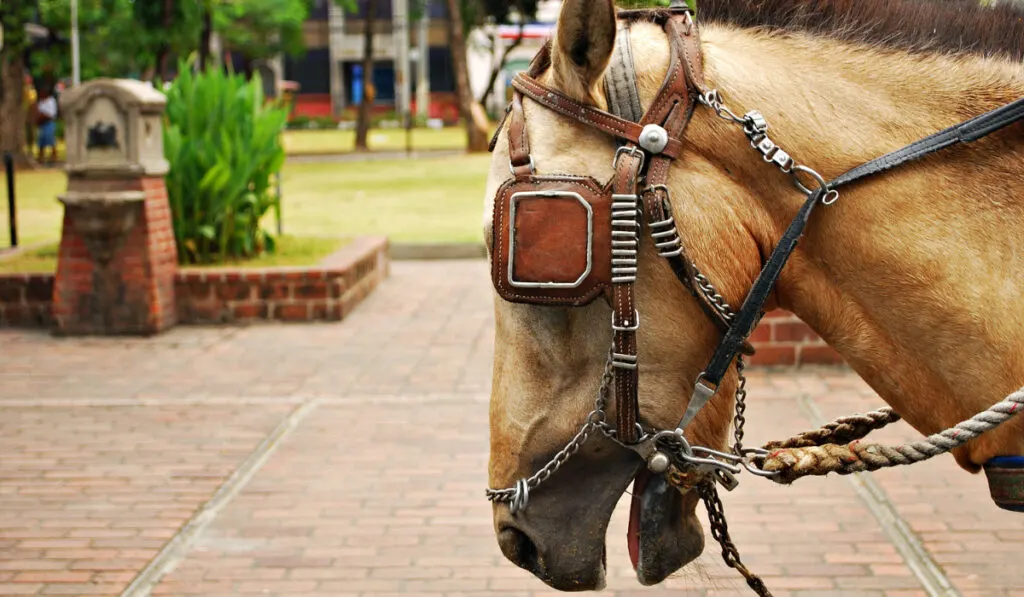
At times, a rider or driver may want to limit his horse’s wide field of vision. There are several reasons for this:
- A working carriage horse in a city may be distracted or frightened by all the sights and movement around him. Focusing his sightline forward eliminates a lot of these distractions or frightening obstacles.
- A racehorse with an excitable temperament may become nervous and distracted if he sees his competitors quickly coming up beside him, or he may find the commotion of the crowd too overwhelming.
- A seasoned lesson horse may become irritated or grouchy if inexperienced riders bring their horses too close. Sometimes, limiting his field of view can make him more relaxed and focused on his rider and his task.
Blinkers and blinders are the two different ways the field of view might be limited. Don’t worry though, the horses can still see straight in front of them and are not completely blinded.
Horses, carriages, and blinkers – oh my!
Humans have used horses and other draft animals to pull wagons and plows for thousands of years. While the tack has certainly changed over the years, the general setup is the same.
A horse that is pulling a carriage, sleigh, plow, or other vehicle will usually wear some sort of bridle and harness. Long reins are attached to the bridle to give the driver control of the horse’s head, and the harness attaches to the vehicle that the horse is pulling. (source)
The horse’s bridle may feature plastic plates that cover his eyes. These plates are called blinkers (or blinders). He can still see just fine, but his field of vision is limited to what’s directly in front of him.
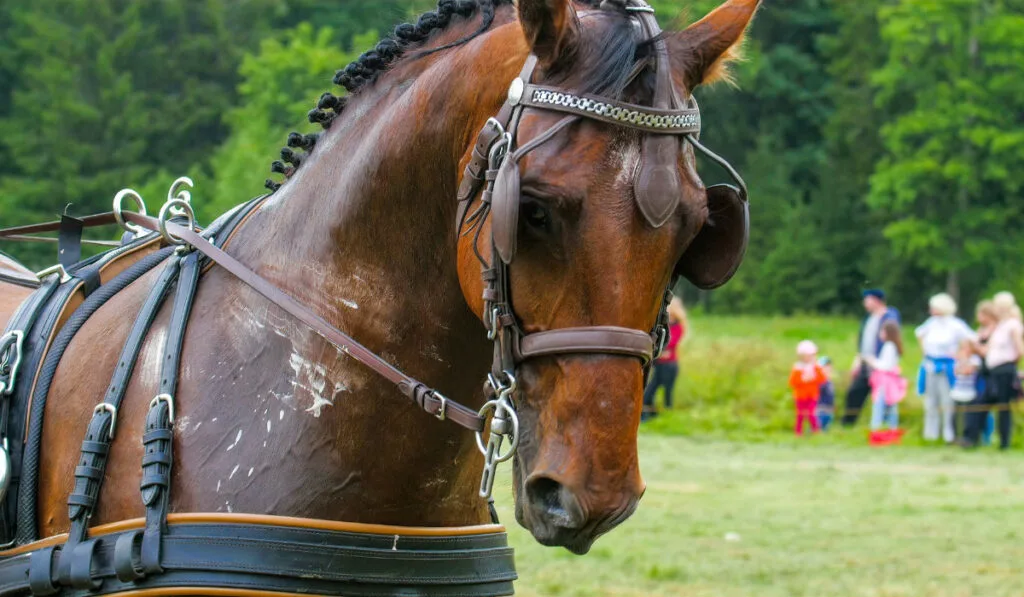
Think about what a carriage or cart looks like to a horse – a big box with large spinning wheels, following you wherever you go! For a nervous horse, this can be a frightening sight. While most seasoned carriage horses can become accustomed to these odd contraptions, it still might be necessary to keep his attention forward instead of behind him.
The History of the Blinker
There may be evidence to suggest that blinkers were originally used to protect the horse’s eyes from being struck with the reins, due to the positioning of harness straps.
However, as harness designs improved due to the increased demand for working carriage horses, blinkers became more popular as fashion statements as well. (source)
Decorative carriages and coaches became status symbols – exceptionally ornate designs were indicators of high class, wealth, and status. Wealthy people adorned their horses’ tack with gold decorations and often affixed their family crests to the blinkers.
Even for people of lower class, coach pulling was no longer a discipline reserved for heavy, docile draft breeds. Farmers needed horses that could handle their ploughs, but also be ready to jump fences while hunting rabbits on the weekends.
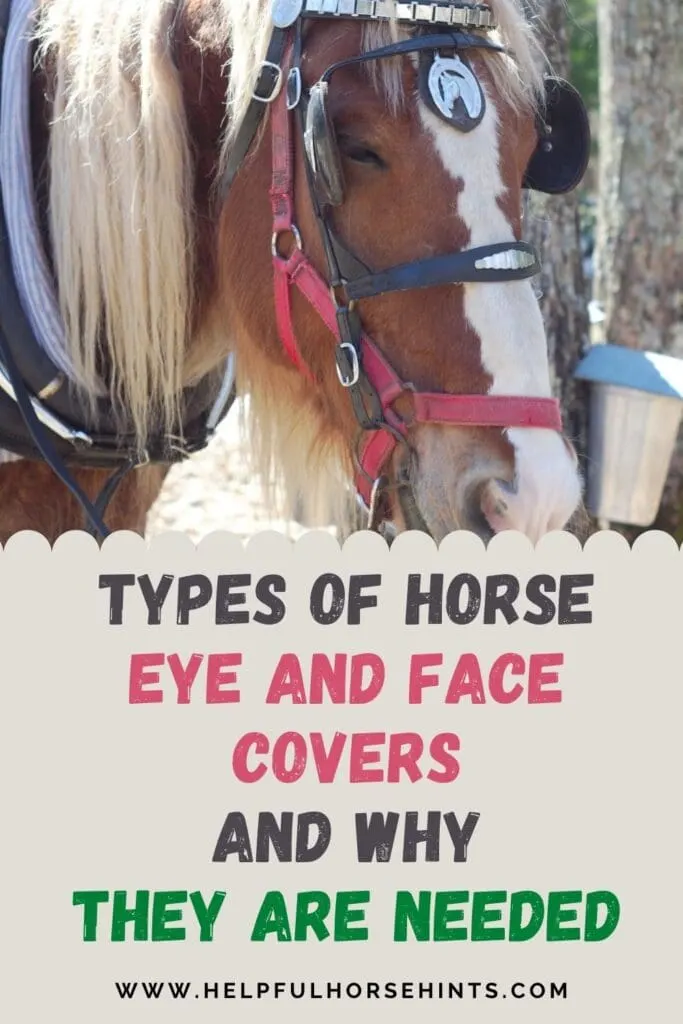
As the use of lighter, more “flighty” breeds increased, handlers were looking for ways to manage them among all the commotion – and they also decorated their horses’ blinkers to emulate the fashion choices of the higher classes.
Blinkers became an easy choice for calming down an anxious horse in a bustling city and showing off with a bit of fashion as well. If all your bridles sported blinkers, it’s easier to swap them between horses if you needed to. It also created a more uniform look – whether or not the horses actually needed them.
On the Racetrack.
Racehorses often wear hoods or visors instead – these soft hoods are fitted with plastic cups in varying shapes, sizes, and colored materials.
Trainers use blinker hoods to get the most out of their horses during a race. Some horses respond well to the addition, especially if they’re susceptible to distractions. Other horses respond poorly, and they become even more anxious – and anxious horses don’t perform at their best.
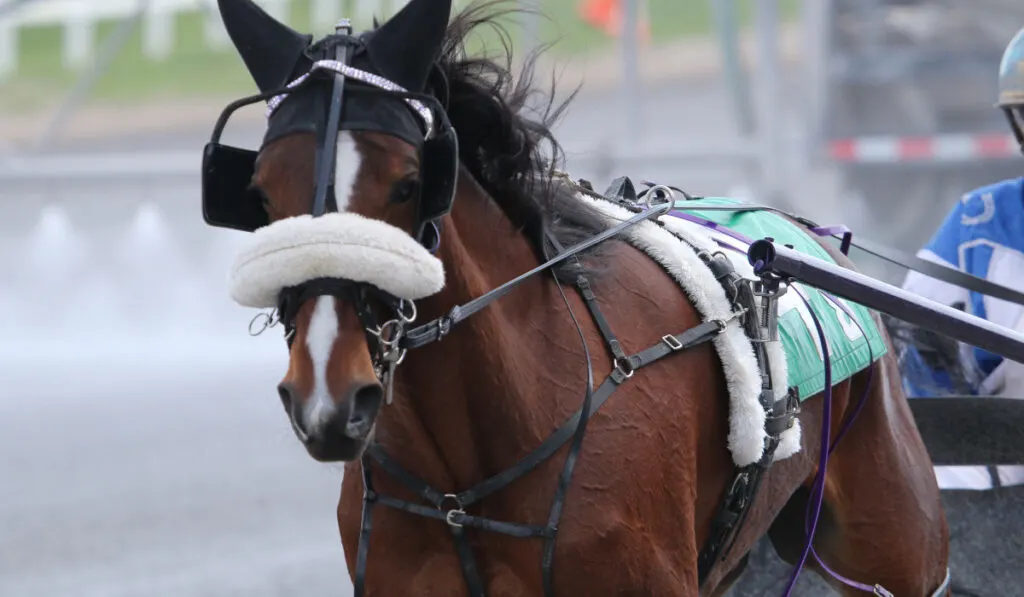
Depending on what country you’re from, using a blinker hood is sometimes viewed as a “cop-out” on the track. The idea is that if a horse needs blinkers, he can’t perform well on his own merit, and he’s not as good as a horse who can win without one. (source)
In America, blinker hoods are common, and even some of the most successful racehorses used them. Secretariat raced to his famous Triple Crown victory in 1973 wearing his signature blue and white checkered blinker hood.
Trotting harness racehorses usually wear blinker hoods, but there’s a lot more going on in their fields of view. Some of them will even wear full visor shields or transparent goggles to protect them from all the flying mud!
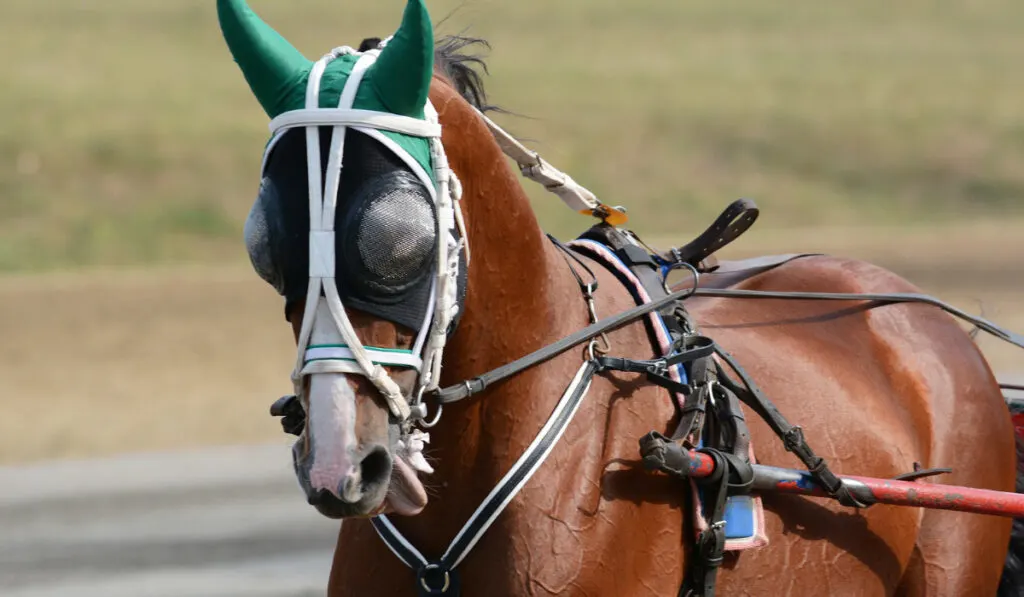
Fly Masks are not Blindfolds
If you see a horse out in a field wearing something that looks like a blindfold, chances are that it’s actually a fly mask. Fly masks are just fashionable hoods that cover a horse’s face with a fine mesh – he can still see through it, but it keeps the flies off his sensitive face and eye areas.
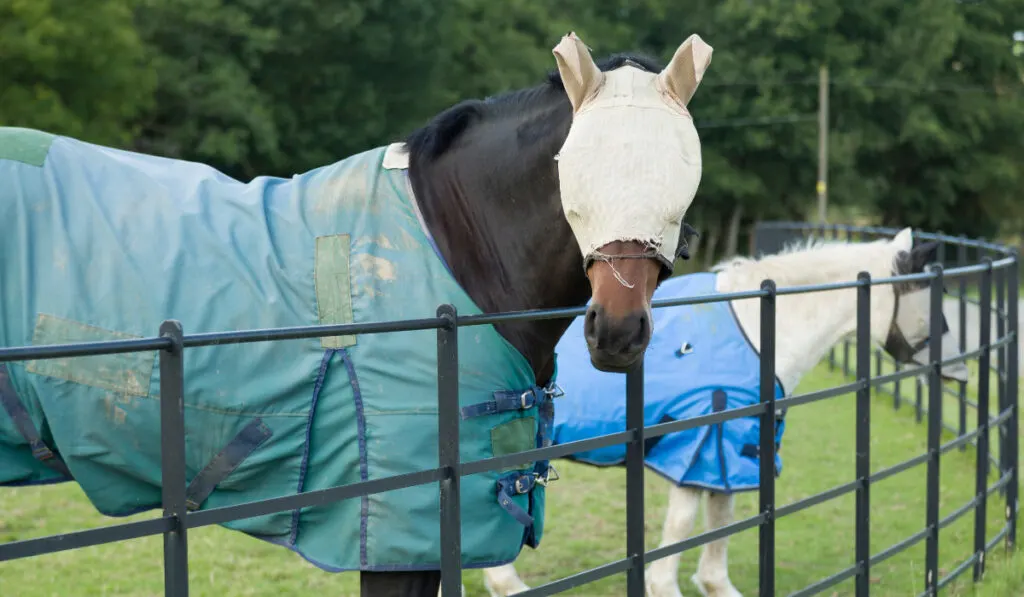
Fly masks come in a variety of styles and colors – some of them cover just the eyes, or extend up over the ears and face. They’re usually made of mesh and soft material, so they’re comfortable for the horse to wear.
In fact, there are so many options that I compiled my favorites fly masks in a single post.
There are many different reasons as to why a horse might be sporting a fly mask:
- Protection from flies and other biting insects. Flies are a nuisance, and some can carry diseases. Horses use their tails to flick flies from their bodies and legs, but sometimes their faces need extra protection.
- Protection from sunlight. Some horses are more sensitive to the UV rays of the sun than others. Light-colored horses with light-colored eyes who live in a sunny region may need extra protection for their delicate eyes. If they spend a lot of time outside or suffer from moon blindness, owners may choose to use a fly mask with UV protection.
- Recovering from illness or injury. Fly masks are often used to protect delicate areas of the face that are healing from trauma or disease. Horses with equine recurrent uveitis (commonly referred to as “moon blindness”) often experience inflammation in their eyes and dilation of their pupils. A fly mask can help protect their delicate eyes during a flare-up.
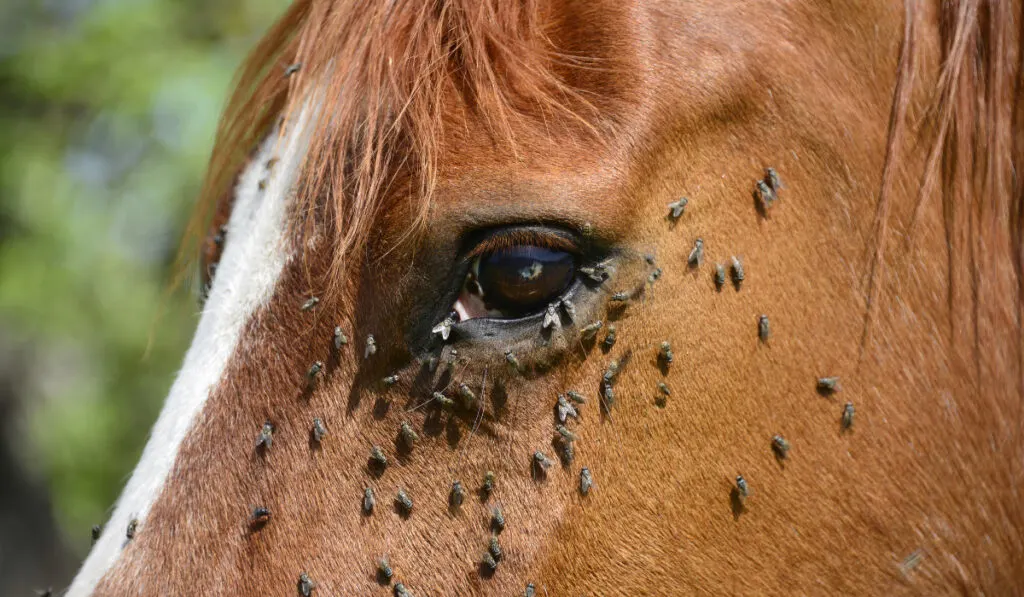
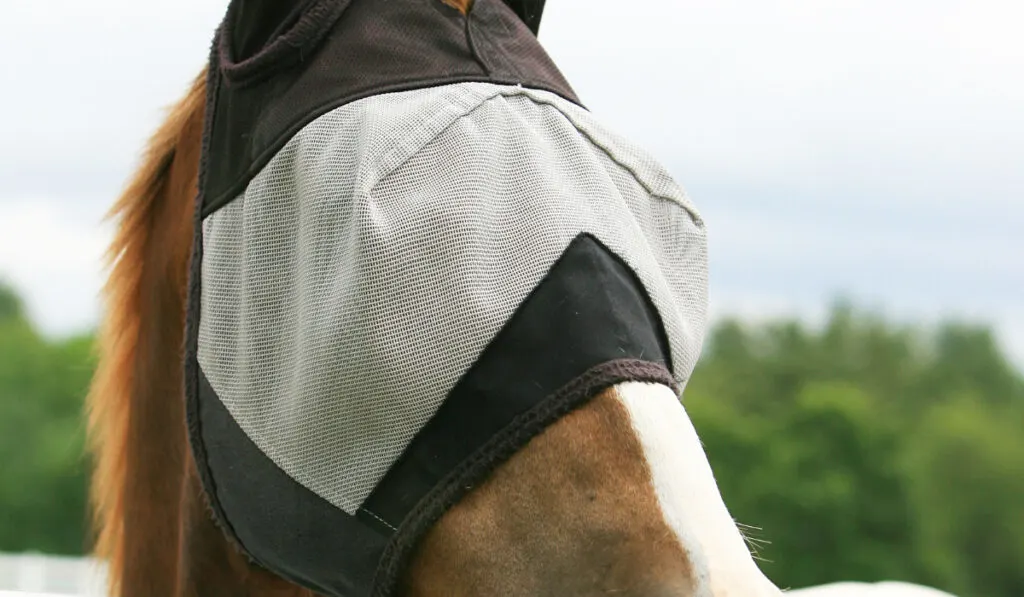
Blindfolds
Because they are natural prey animals, horses rely on their vision to feel comfortable with their surroundings. If you see a horse wearing a hood or other eye covering, it’s likely not a blindfold at all. However, there are some specific circumstances in which a horse must be completely blindfolded.
- While trailering or loading into a starting gate. Horses have excellent night vision, but they struggle to transition from areas with bright lights to areas with low light. A dark trailer or enclosed starting gate can be frightening. Trainers may use a blindfold to practice loading and unloading from these stressful objects – but the bonds of trust must be established first.
- During an emergency. There’s a famous scene in Anna Sewell’s classic book Black Beauty: There’s a fire at the barn, and the horses are too afraid to leave. The groom blindfolds them and leads them out to safety. Blindfolds can calm a nervous horse, especially if he’s around someone that he trusts.
- Medical needs. Horses enduring surgery or other medical procedures may be blindfolded. A nervous horse may not understand all the strange-looking medical equipment, and he may be easier to handle if he doesn’t see it. A horse recovering from eye or face injuries may be blindfolded to protect his healing eyes.
It’s probably not a blindfold at all!
Generally speaking, a horse can still see just fine with his vision partially obscured. True blindfolds are a rare sight, and you’re probably looking at a fly mask or blinkers instead.
If you’re considering using blinkers on your horse, keep in mind that every horse is an individual – some may benefit from having their vision limited, but others may react poorly.
Use care and proper training when using a blinker hood on your horse, and always consult a professional if you’re unsure how to proceed.

